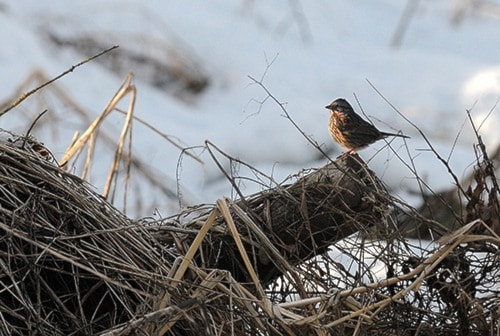A bit of sun, a bit of rain and a bit of time did what thousands of shovels, picks and plows and tonnes of salt couldn’t do over the past few weeks.
The forecast was for clear and temperatures around 0 C for the middle of this week, with gradual warming to 5 C with mixed rain and snow on Sunday.
“We’re getting into clean-up mode, that’s for sure,” said Forrest Smith, director of engineering and operations for the City of Pitt Meadows.
A snowfall on New Year’s Eve dumped up to 20 centimetres in Maple Ridge and Pitt Meadows and had crews from both cities scrambling over the holidays.
Smith said nine trucks were out on Pitt Meadows streets on New Year’s Eve, spreading salt and sand. However, the snow came down so fast that by the time crews got to side streets, the snow had become packed and turned to ice.
“Our biggest challenge was with the side roads. All our main roads we kept pretty bare for most of the event.”
Luckily, snow forecast for this past Sunday didn’t materialize.
In addition to applying salt and sand, crews are cleaning catch basins to ensure melting snow drains away.
Smith said the present weather forecasts are calling for a slow warm-up, followed by cooler weather later on.
“It looks like we’ll get a bit gradual clearing.”
He added that the New Year’s Eve snow was considered a medium-intensity snow storm, with crews working around the clock until the main and collector roads were clear.
Once those have been plowed, the city goes back to a regular schedule.
So far, the City of Pitt Meadows has spent about $150,000 during the three-week cold spell.
In Maple Ridge, the war against winter has cost almost half a million dollars.
Director of engineering operations James Storey said about half of that was used to buy road salt, while the other half was for staffing and equipment costs.
During the New Year’s Eve storm, Maple Ridge had 12 plowing or sanding vehicles on the road.
Sunday night, with more snow forecast, Maple Ridge had two trucks out spreading brine with the same happening Monday night.
“We had a little bit of ice this morning [Monday] that was easy to quickly catch.”
With some dry days this week, the weather should be good for spreading brine.
“We’ll have our guys out. They know the trouble spots, the bottom of the hills, the shady spots. They’ll be checking those and applying as required.”
Storey updated council on Monday and said later that with a total of 44 employees available, it’s impossible to spare the time to also shovel sidewalks. That’s labour intensive and takes time to remove.
Instead, public works crews focused on the roads and keeping power on at several sewer substations that had their power knocked out. Without power, the whole sewage system could have backed up.
“Potentially, there could have been a lot of back-ups,” he said.
“It’s one of those things, you get the snow and then you have to deal with everything else.”
During the cold spell, Maple Ridge also consumed more than 1,200 tonnes of road salt. But the salt doesn’t work even at temperatures of minus-3 C, he added.
Calcium chloride or other types of ice melt spread works at lower temperatures. If the weather gets colder, sand is used.
Once the snow got packed on to the road and ice formed, “we pounded the salt into it and it would not melt that ice fast enough,” Storey said.
The last big snow storm in Maple Ridge was 2009, he added.
Once all the snow and ice melts, it will find its way to local streams and fish.
Ross Davies, with Kanaka Education and Environmental Protection Society, said it could stress amphibians and fish. He doesn’t oppose spreading salt, but said that levels of chloride higher than 800 parts per million can affect how fish and animals regulate the flow of water fluids.
“The effects are probably felt the most in the smaller streams that are close to busy, often salted roads, and by the youngest fish, where the stress of the high salinity might drive them out of an area,” Davies said.
Higher salinity water in small ponds or lakes tends to sink to the bottom and reduce the water and oxygen circulation in that body of water, he added.
‘Don’t skate on the lake’
As cold as it has been, and as much fun as it to skate on local lakes, ponds and rivers, doing so is not safe. Ridge Meadows, along with the cities of Maple Ridge and Pitt Meadows, and fire departments from both, urged citizens on Friday to avoid skating or any activity on ice-covered waterways.
Although local temperatures have gone below zero, and ponds may have frozen, none have been deemed safe.
“While we appreciate that a pickup game of hockey on a frozen pond is part of our Canadian DNA, the reality is that the ice conditions are not reliable for this type of activity,” said David Boag, director of parks and facilities for Maple Ridge.
“The same goes for streams and waters adjacent to our trail network. As the temperatures fluctuate, we are concerned that citizens and their pets are at risk venturing onto ice.”
Ice on lakes, ponds and rivers poses a significant safety risk.
“Be safe and stay on the shores and enjoy the great outdoors,” said RCMP Sgt. Brenda Gresiuk.
